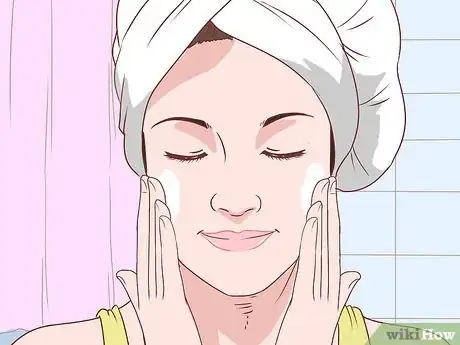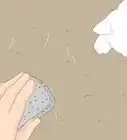This article was medically reviewed by Luba Lee, FNP-BC, MS. Luba Lee, FNP-BC is a Board-Certified Family Nurse Practitioner (FNP) and educator in Tennessee with over a decade of clinical experience. Luba has certifications in Pediatric Advanced Life Support (PALS), Emergency Medicine, Advanced Cardiac Life Support (ACLS), Team Building, and Critical Care Nursing. She received her Master of Science in Nursing (MSN) from the University of Tennessee in 2006.
There are 13 references cited in this article, which can be found at the bottom of the page.
wikiHow marks an article as reader-approved once it receives enough positive feedback. This article received 15 testimonials and 84% of readers who voted found it helpful, earning it our reader-approved status.
This article has been viewed 2,193,232 times.
Dry skin on your face is irritating and uncomfortable. Luckily, there are simple strategies that can help. Changing your facial cleansing routine may reduce dryness in your skin. You can also reduce the amount of moisture you lose by doing things like taking shorter showers and using a humidifier. Adjusting your diet and trying supplements may also help. If all else fails and you are still dealing with dry skin, see your doctor or a dermatologist.
Steps
Adjusting Your Cleansing Routine
-
1Choose a gentle cleanser free from fragrances, alcohol, and dyes. These ingredients may further dry out your skin. Check the label on any facial cleanser you are considering buying to ensure that it does not contain these ingredients. Opt for a cleanser meant for dry skin for best results.[1]
- For example, you can purchase a soap-free cleanser, such as Cetaphil or Aquanil.
-
2Wash your face twice daily with lukewarm water and a gentle cleanser. Wet your face with cool or lukewarm water by cupping the water in your hands and splashing it onto your face. Work the cleanser into your skin with your fingertips using small circular motions. Then, rinse the soap off of your face by wetting it again.[2]
- Do not scrub your skin with a sponge or washcloth because this will strip extra oils from your skin and dry it out even more.[3]
- Don’t use hot water to wash your face as this may dry out your skin even more.
Tip: Wash your face after you wake up and before you go to bed. Don’t wash your face more frequently than this or you may dry it out. However, it is also important to wash your face after any period of sweating excessively, such as after a workout.
Advertisement -
3Pat your face dry with a clean towel. After you finish washing and rinsing your face, get a clean, dry towel and pat your face with it. Do not rub the towel against your skin as this will dry it out more. Gently pat your face all over with the towel to dry it off.[4]
- You can use a regular towel, or try a microfiber towel or T-shirt for an even softer option.
-
4Select a moisturizer that includes oil or shea butter or other emollients. These ingredients work well for treating dry skin on your face. Look at the label to check for 1 or both of these ingredients. You may also want to choose a cream or ointment moisturizer rather than a lotion. Look for something that is labeled as “intensive” or that is meant for treating dry skin.[5]
- Other ingredients that may help to moisturize dry skin include dimethicone, glycerin, hyaluronic acid, lactic acid, lanolin, mineral oil, petrolatum, and urea. Check the ingredients on moisturizers you consider buying to see if it contains any of these ingredients.
-
5Apply moisturizer to your face right after cleansing. This is the best time to lock in moisture and get rid of dry skin. Apply enough moisturizer to your skin to fully coat it, and then let the moisturizer sit on your skin until your skin absorbs it. Use your fingertips to smooth the moisturizer all over your face and neck.[6]
- You may only need a pea-sized amount to cover your whole face, so start with that amount and then apply more moisturizer if needed.
-
6Apply aloe vera gel to your skin for extra moisture. Using pure aloe vera gel on your skin once or twice per day may help to reduce dryness. Use aloe vera gel in place of or in addition to your usual moisturizer after you wash your face. Apply enough aloe to coat your skin and allow it to absorb.[7]
- You can purchase pure aloe vera gel in a drug store or grocery store.
- Make sure that the aloe gel does not contain any other ingredients, such as fragrances, dyes, alcohol, or lidocaine (for numbing a sunburn). These are likely to irritate your dry skin.
-
7Treat your skin with a weekly mask of manuka honey. Using manuka honey on your skin may help to reduce dry skin on your face.[8] Apply a thin layer of manuka honey to your skin after cleansing it. Then, let the honey sit on your skin for 10 minutes before rinsing it off with lukewarm water. Repeat this once or twice weekly for a deep moisturizing treatment.[9]
- You can buy manuka honey in specialty food stores and online.
- If you cannot find manuka honey, use regular honey instead.
Keeping Moisture in Your Skin
-
1Run a humidifier whenever you’re home. A humidifier adds moisture back into the air, and this may help to reduce dryness in your skin. Keeping a humidifier running while you’re home may help to lock more moisture in your skin and reduce dryness. Try running a humidifier in your bedroom at night to promote a moister environment.[10]
- You can also run your humidifier during the daytime if you’ll be home for a few hours. Place it in whatever room you are in and switch it on.
-
2Limit your showers and baths to no more than 10 minutes. Long showers and baths may be relaxing, but they can make dry skin worse. Time yourself and try to keep your showers and baths between 5 and 10 minutes to reduce their drying effects.[11]
Tip: Make sure to close the bathroom door to keep moisture in during showers and baths. Keeping the door open during a shower or bath will allow moisture to escape and this can dry out your skin.
-
3Avoid sitting directly in front of a heat source to stay warm. If you’re cold, put on warm clothing and wrap yourself in a blanket to keep warm. Don’t sit directly in front of a fireplace, space heater, or heating duct as this may dry out your skin even more.[12]
- On extra cold nights, try using an electric blanket to stay warm. If you don’t have one, toss a blanket into the dryer for 5 to 10 minutes to warm it up and then wrap yourself up in it.
Using Diet and Supplements
-
1Drink water whenever you are thirsty. Staying well-hydrated can help to promote healthier skin that is less prone to dryness. Drink a glass of water whenever you feel thirsty and at times when you would normally drink something, such as at mealtimes and after exercising.[13]
- Try keeping a reusable water bottle with you and refilling it throughout the day.
-
2Avoid alcohol or limit your intake to no more than every other day. Drinking alcohol dries out your skin because alcohol is a diuretic, which means it pulls water from your body. If you suffer from dry skin and you drink alcohol regularly, cutting it out can have a dramatic effect on your skin’s appearance. Try to limit yourself to no more than 1 to 2 drinks every other day if you do drink.[14]
- It might take a few weeks before you notice the effects of not drinking on your skin.
Tip: If you plan to abstain from drinking alcohol for 30 days or longer, try taking a before and after picture to see how your skin changes from not drinking.
-
3Eat vitamin C-rich foods to promote healthy skin. Vitamin C is a potent nutrient for skin health. If you suffer from dry skin on your face, start eating more vitamin C-rich foods to see if this helps. Some good options include:[15]
- Citrus fruits, such as oranges, grapefruit, lemon, and limes
- Kiwi, mangoes, and papaya
- Strawberries, blueberries, and raspberries
- Cantaloupe and honeydew melon
- Broccoli, cauliflower, and kale
- Potatoes and sweet potatoes
- Red bell peppers
-
4Try taking a hair, skin and nail vitamin to promote overall skin health. Hair, skin, and nail vitamins may help to promote healthier skin and reduce dryness if you take them over time. Look for a multivitamin that is meant to promote hair, skin, and nail health and take it daily according to the manufacturer’s instructions. These supplements usually contain a combination of vitamins A, B, C, and E, but some may also contain omega-3 fatty acids and other ingredients.[16]
- You can also get vitamins directly delivered into your bloodstream as part of intravenous therapy (IV), using a short plastic tube inserted into your vein.[17] This is only performed by a licensed medical professional, so you should ask your doctor if this method would work for you.
- Check with your doctor before you start taking any supplements, especially if you regularly take a prescription medication or over-the-counter drugs or supplements.
Seeking Medical Help
-
1Call your doctor if you notice redness, itchiness, cracking, or bleeding. If your skin is red, itchy, cracking, or bleeding, call your doctor to make an appointment as soon as possible. These may be signs that your skin is infected or that it may become infected if left untreated. Your doctor may treat any cracks in your skin with a combination of medication and wet-dressings.[18]
Warning: If you have a rash, swelling, pain, or pus draining from any part of your face, this may indicate that you have a skin infection. See a doctor immediately for treatment.[19]
-
2See a dermatologist for a prescription dry skin cream if it’s severe. If your dry skin does not improve no matter what you try, you might need to see a dermatologist for help. They can prescribe a special cream or ointment to help rehydrate your skin and reduce irritation.[20]
- If you have a condition, such as psoriasis, that is contributing to your dry skin, your doctor may also prescribe something to treat that.
-
3Ask your doctor to check your thyroid. Hypothyroidism, which is when you have an underactive thyroid, can also cause dry skin. This condition requires a diagnosis from a healthcare professional and your doctor will prescribe medication to treat the underactive thyroid if you have it. Other symptoms of hypothyroidism include:[21]
- Fatigue
- Sensitivity to cold
- Weight gain
- Puffy face
- Thinning hair
- Heavy periods
- Depression
- Impaired memory[22]
Expert Q&A
Did you know you can get expert answers for this article?
Unlock expert answers by supporting wikiHow
-
QuestionHow do I take a milk bath?
 Luba Lee, FNP-BC, MSLuba Lee, FNP-BC is a Board-Certified Family Nurse Practitioner (FNP) and educator in Tennessee with over a decade of clinical experience. Luba has certifications in Pediatric Advanced Life Support (PALS), Emergency Medicine, Advanced Cardiac Life Support (ACLS), Team Building, and Critical Care Nursing. She received her Master of Science in Nursing (MSN) from the University of Tennessee in 2006.
Luba Lee, FNP-BC, MSLuba Lee, FNP-BC is a Board-Certified Family Nurse Practitioner (FNP) and educator in Tennessee with over a decade of clinical experience. Luba has certifications in Pediatric Advanced Life Support (PALS), Emergency Medicine, Advanced Cardiac Life Support (ACLS), Team Building, and Critical Care Nursing. She received her Master of Science in Nursing (MSN) from the University of Tennessee in 2006.
Board-Certified Family Nurse Practitioner
-
QuestionCan retinol help dry skin spots?
 Luba Lee, FNP-BC, MSLuba Lee, FNP-BC is a Board-Certified Family Nurse Practitioner (FNP) and educator in Tennessee with over a decade of clinical experience. Luba has certifications in Pediatric Advanced Life Support (PALS), Emergency Medicine, Advanced Cardiac Life Support (ACLS), Team Building, and Critical Care Nursing. She received her Master of Science in Nursing (MSN) from the University of Tennessee in 2006.
Luba Lee, FNP-BC, MSLuba Lee, FNP-BC is a Board-Certified Family Nurse Practitioner (FNP) and educator in Tennessee with over a decade of clinical experience. Luba has certifications in Pediatric Advanced Life Support (PALS), Emergency Medicine, Advanced Cardiac Life Support (ACLS), Team Building, and Critical Care Nursing. She received her Master of Science in Nursing (MSN) from the University of Tennessee in 2006.
Board-Certified Family Nurse Practitioner
References
- ↑ https://www.health.harvard.edu/staying-healthy/9-ways-to-banish-dry-skin
- ↑ https://www.aad.org/public/skin-hair-nails/skin-care/dry-skin
- ↑ https://www.health.harvard.edu/staying-healthy/9-ways-to-banish-dry-skin
- ↑ https://www.aad.org/public/skin-hair-nails/skin-care/dry-skin
- ↑ https://www.aad.org/public/skin-hair-nails/skin-care/dry-skin
- ↑ https://www.aad.org/public/skin-hair-nails/skin-care/dry-skin
- ↑ https://www.ncbi.nlm.nih.gov/pubmed/12548256
- ↑ https://www.ncbi.nlm.nih.gov/pmc/articles/PMC4112259/
- ↑ https://www.self.com/story/manuka-honey-skin-care
- ↑ https://www.aad.org/public/skin-hair-nails/skin-care/dry-skin
- ↑ https://www.aad.org/public/skin-hair-nails/skin-care/dry-skin
- ↑ https://www.aad.org/public/skin-hair-nails/skin-care/dry-skin
- ↑ https://www.ncbi.nlm.nih.gov/pmc/articles/PMC4529263/
- ↑ https://www.vogue.com/article/alcohol-skin-damage-effects?verso=true
- ↑ https://lpi.oregonstate.edu/mic/health-disease/skin-health/vitamin-C
- ↑ https://www.ncbi.nlm.nih.gov/pmc/articles/PMC4112259/
- ↑ https://pubmed.ncbi.nlm.nih.gov/33523616/
- ↑ https://www.mayoclinic.org/diseases-conditions/dry-skin/diagnosis-treatment/drc-20353891
- ↑ https://medlineplus.gov/skininfections.html
- ↑ https://www.mayoclinic.org/diseases-conditions/dry-skin/diagnosis-treatment/drc-20353891
- ↑ https://www.mayoclinic.org/diseases-conditions/dry-skin/diagnosis-treatment/drc-20353891
- ↑ https://www.mayoclinic.org/diseases-conditions/hypothyroidism/symptoms-causes/syc-20350284
About This Article
To get rid of dry skin on your face, start by washing your face with warm water using a mild cleanser that doesn't have fragrances or soap in it. After you wash your face, apply a strong moisturizer to your skin that has ingredients like shea butter, glycerin, and ceramides. Gently exfoliate your face 2-3 times a week with a damp baby’s washcloth. For more ways you can get rid of dry skin on your face, like using face masks and a humidifier, keep reading!






















-Step-8-Version-3.webp)





















































